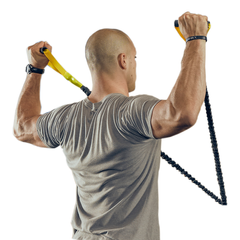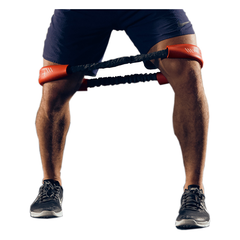The entire athletic world knows that getting the body ready with a great warm-up will help improve performance and stave off injury.
But that’s like saying, “It’s a good idea to save for retirement.” Yes, it’s a good idea, but putting it into practice is easier said than done. There are important things that need to be included in every athlete’s warm-up to maximize the return on the investment.
We hope to eliminate confusion about the best pre-training routine and define the what and why of the ultimate warm-up program.
For a long time, light jogging and stretching were commonplace in the warm-up to help “loosen” things up. We then learned that moving through ranges of motion was a better approach, this became known as a “dynamic warm-up.”
However, the dynamic warm-up can be made even better with targeted muscle activation, a term that requires some explanation.
It’s important to understand that the focus of muscle activation isn’t to create changes in the muscles but instead focus on what’s controlling them. The muscles themselves are NOT turned off, and outside of rare nerve issues, your muscles will contract when they receive a strong enough signal from the nervous system.
However, telling the muscle to contract is not as easy as loading up a movement program in the brain and pressing play. First, the nervous system must gather a ton of information from the sensory receptors in the muscles, joints, and tendons, then tell groups of muscle fibers to contract based on that information.
Those sensory receptors are unaware that you want to perform a perfect lift. They are only aware of specific information in that region, such as muscle stiffness, length, or potential damage.
Therefore the brain must organize a big movement—like a squat, Olympic lift, or long throw— based on the last 8 hours of sitting, the effects of a previous workout, or sometimes the perception that there is damage in a certain part of the body. This all impacts movement outcomes.
Therefore, a better term for muscle activation is actually Movement Activation.
It breaks down bigger movements into smaller pieces, which allows the brain to dial in mobility and coordination within the body for better movement. It fires key muscle groups needed for the bigger lifts by generating new commands about muscle stiffness, range of motion, and what might cause pain if dealing with an injury.
This “optimized movement” will then be better equipped to take on the demands of the activity at hand. With muscle activation, the joints will feel more mobile and positions will feel more stable.
The Long-Term Gains
Although the benefits of a great warm-up extend beyond just a great workout.
That’s because mastery happens with daily practice.
Without getting into the complexities of neuroanatomy, there is a simple truth that with practice, you get better at things. It’s a sports performance fundamental that often gets overlooked in strength training.
Huge improvements in strength and movement happen by teaching the brain to control the muscles better. It’s an important reason we get strong so fast in the first couple of months of a workout program.
The brain improves its ability to:
- Contract more and bigger muscle sections
- Coordinate between muscle groups
- Increase the speed of communication from the nervous system to the muscles
Without practice and repetition, the brain gets stuck in a hole of limited movement solutions, which forces it to rely on only a few of the pieces. But after thousands of repetitions, movement patterns become more fluid as the brain learns to coordinate and use the many muscles of the body better.
The daily warm-up is a perfect time to do this movement training.
Not only will it optimize the body for the upcoming activity, but it also doesn’t have the bigger, faster, stronger mentality of the actual workout. The goal of your warm-up has probably never been to hit your next warm-up PR! Therefore, the low intensity of the warm-up is a chance to take a step back and find focus on improving movement quality.
The long-term gains from the daily “movement practice” as part of the Crossover Primer, will yield benefits of optimizing movement and keeping the body healthy and pain-free. These things are just as important as the results you will get from that day’s workout program.
There are 2 pitfalls that often plague warm-up programs.
-
Too Little- Every warm-up should check the neurological and physiological needs to be maximally effective (we talk more about that here: The Must-Haves for Any Warm-Up). A 5 minute run with some squats and push-ups leaves out a ton of benefits that could be achieved by doing just a little bit more.
- Too Much- Too much complexity can be just as detrimental as not doing enough. First of all, throwing in a laundry list of exercises takes away from precious training and practice time. Secondly, an overly complicated warm-up is less likely to get done, therefore limiting the results. Lastly, gathering and setting up equipment, and then the time to learn new exercises, is often at the detriment of getting hot and getting moving.
Specific to the Crossover Primer, it’s designed it to get the body ready to go, while solving common movement impairments, in a way that’s easy to fit into an everyday training program.
It’s the ultimate solution to getting your body ready, along with a daily dosage of movement needed for a lifetime of health and performance.
Learn more about the Crossover Primer here and stop missing out on gains or setting yourself up for injury because of poor training preparation.
 Shoulder Packages
Shoulder Packages
 Hip & Core Package
Hip & Core Package
 NEW - Crossover TORQ
NEW - Crossover TORQ
 Bundles
Bundles
 Accessories
Accessories
























